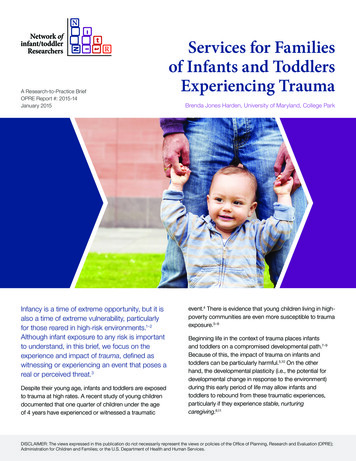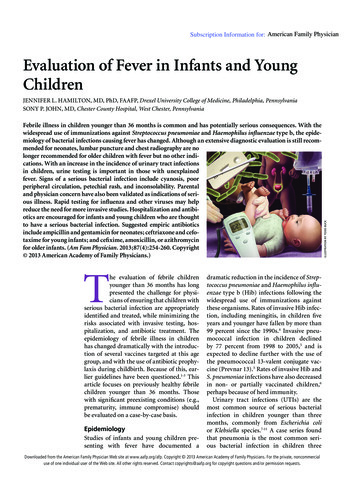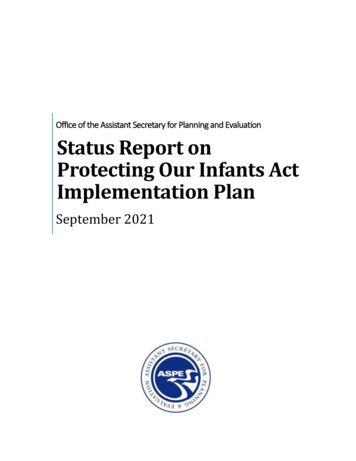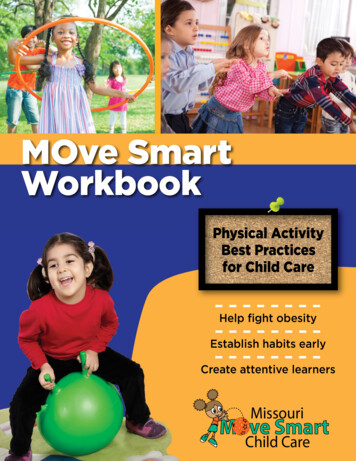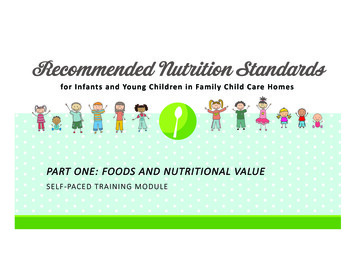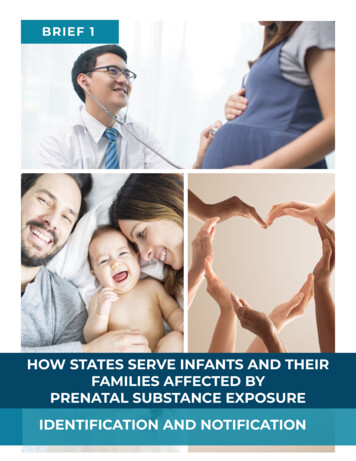
Transcription
BRIEFBRIEF 11HOW STATES SERVE INFANTS AND THEIRFAMILIES AFFECTED BYPRENATAL SUBSTANCE EXPOSUREIDENTIFICATION AND NOTIFICATION
OVERVIEWThe National Center on Substance Abuse and Child Welfare (NCSACW), with support from theAdministration on Children, Youth and Families (ACYF) Children’s Bureau (CB), has developed a seriesof briefs highlighting states’ approaches to serving infants and their families affected by prenatalsubstance exposure. These briefs derive from NCSACW’s review of states’ Annual Progress andServices Reports (APSRs) pertaining to Section 503 “Infant Plan of Safe Care” of the Child Abuseand Prevention Treatment Act (CAPTA) and years of practice-based experience providing technicalassistance (TA) to support systems-level policy efforts and practice-level innovations to improveoutcomes for these infants and families.NCSACW HELPS STATES AND COMMUNITIES IMPROVE OUTCOMES FOR INFANTSAND THEIR FAMILIES AFFECTED BY PRENATAL SUBSTANCE EXPOSURESince the passage of the Comprehensive Addiction and Recovery Act (CARA) amendmentsto CAPTA in 2016, NCSACW has Responded to over 3,000 TA requests related to the prenatal substance exposureprovisions in CAPTA, Plans of Safe Care, and neonatal abstinence syndrome Engaged 17 sites—including five Tribes and one county—in its In-Depth TechnicalAssistance program to support their efforts to implement the CARA amendments toCAPTA Convened two Policy and Practice Academies (2017, 2020) with 18 state teams and onecounty team to provide consultation on collaborative strategies to improve outcomes forinfants and their families affected by prenatal substance exposure Supported two regional convenings—along with the Department of Health and HumanServices regions 4, 6, 7, and 9, and their respective state teams—to advance theircapacity to improve the safety, permanency, recovery, and well-being of infants and theirfamilies Visited eight state child welfare agencies in 2018 and 2019 to gain a greaterunderstanding of the states’ policies and practices related to the CARA amendments toCAPTA. The site visits provided a forum to: 1) identify promising and best practices (aswell as the challenges and barriers to the implementation of Plans of Safe Care), 2) learnabout multidisciplinary efforts by the state to support implementation, and 3) identify TAneeds Conducted 40 virtual and in-person interviews with child welfare, substance usetreatment, healthcare, and legal professionals to gather information on how states andlocalities are serving infants and their families affected by prenatal substance exposureHOW STATES SERVE INFANTS AND THEIR FAMILIES AFFECTED BY PRENATAL SUBSTANCE EXPOSUREIDENTIFICATION AND NOTIFICATION.1
BRIEFS IN THIS SERIESBRIEFIdentification and NotificationBRIEFPlans of Safe Care Data and MonitoringBRIEFLessons from Implementation of Plans of Safe CareINTRODUCTIONCAPTA was amended by the Comprehensive Addiction and Recovery Act (CARA) in 2016. Thelegislation changed some requirements of states’ assurances related to Plans of Safe Care. Familiesfalling under the new requirements included infants born with, and identified as being affected by,substance abuse or withdrawal symptoms resulting from prenatal drug exposure, or a fetal alcoholspectrum disorder, and their affected family or caregivers.1 There is also a provision that health careproviders involved in the delivery or care of such infants notify their local Child Protective Services(CPS) system.Brief #1: Identification and Notification summarizes steps states took to implement the CARAamendments to CAPTA. This brief focuses on modifications to state statutes of child abuse and neglect,establishing a difference between notifying and reporting to CPS, and developing shared definitions toidentify and serve infants and their families affected by prenatal substance exposure.STATUTE MODIFICATIONSStates have a wide range of experiences implementing the CARA amendments to CAPTA as specificchild maltreatment statutes guide agency policies, procedures, and strategies that states operationalize.Since 2018, 28 states have described modifications to their state statutes in their APSRs. Most of thesemodifications took place in 2017 following the passage of the CARA amendments to CAPTA. For manystates, statute modifications were an initial step toward achieving compliance with CARA. The mostcommon changes related to Modifying the statutory definition of child maltreatment to include aspects of prenatal substanceexposure Changing the process for notifying CPS about infants identified as affected by prenatal substanceabuseFrom NCSACW’s work providingtechnical assistance, stakeholdershave reported that child maltreatmentstatutes can deter pregnant womenfrom seeking health care, including earlyprenatal care and substance use disordertreatment, to avoid a maltreatmentreport to CPS at the time of delivery.HOW STATES SERVE INFANTS AND THEIR FAMILIES AFFECTED BY PRENATAL SUBSTANCE EXPOSUREIDENTIFICATION AND NOTIFICATION. 2
Some states have modified their statutes to clarify identification, notification, and reporting; and toachieve broader engagement of other systems to meet the CARA amendments to CAPTA, includingdesignating other systems beyond child welfare to develop a Plan of Safe Care.NCSACW has found that a distinction between a report and notification to CPS can supportparental engagement in services and increase provider engagement in the development of Plans ofSafe Care. Implementing Plans of Safe Care for infants and their families or caregivers not involvedin the child welfare system through partnerships with community-based agencies can provideaccess to needed services and supports while preventing future child welfare involvement.STATE HIGHLIGHT: NEW MEXICOIn July 2019 New Mexico implemented House Bill 230: Plans of Care forSubstance-Exposed Newborns. The law requires health care professionals toassess whether an infant has been exposed to substances at birth. Plans ofCare are required for any newborn identified as having been exposed to anysubstance at any time during the pregnancy. Once the health care professionalcreates a Plan of Care, they must make a referral to the Medicaid managed careorganization or children’s medical services for care coordination and monitoring.This law also changed New Mexico’s Children’s Code to specify that substance use on its own isnot considered abuse or neglect. Health care professionals concerned about a parent’s ability tocare for the infant still make referrals to New Mexico’s Children, Youth and Families Department(CYFD). The change in the statute is designed to help families remain together, mitigate safetyconcerns, and provide individualized support and services.New Mexico is currently gathering data directly from families who participated in a Plan of Careto understand what worked well and identify opportunities for improvement. New Mexico isalso examining its child welfare data for families with a Plan of Care to understand how manyhad CYFD involvement and where the infants currently reside (in state custody, with biologicalparents, or other placements). In the future, New Mexico plans to do a comparison study usinga cohort of families that had an infant with prenatal substance exposure and CYFD involvementprior to the state law change to determine any differences in child welfare outcomes.STATE HIGHLIGHT: LOUISIANAIn 2017 Louisiana passed House Bill 678, Act 359 to establish “if a newbornexhibits symptoms of withdrawal or other observable and harmful effects in hisphysical appearance or functioning that a physician believes are due to the useof a controlled dangerous substance, as defined by R.S. 40:961 et seq., in alawfully prescribed manner by the mother during pregnancy, the physician shallmake a notification to the Department of Children and Family Services (DCFS)on a form developed by the department. Such notification shall not constitute areport of child abuse or prenatal neglect, nor shall it require prosecution for any illegal action.”The state’s Physician Notification of Substance Exposed Newborns, No Prenatal Neglect Suspected formis for data-gathering purposes and provides DCFS with the following essential information: Substances to which the newborn was exposed, if known Whether or not a neonatal abstinence screening was completed Pertinent discharge referral information and educational resources provided to the mother, ifapplicable.HOW STATES SERVE INFANTS AND THEIR FAMILIES AFFECTED BY PRENATAL SUBSTANCE EXPOSURE. 3IDENTIFICATION AND NOTIFICATION
THE DIFFERENCE BETWEEN NOTIFICATION AND REPORTTO CHILD PROTECTIVE SERVICESAlthough CAPTA includes a requirement that health care providers involved in the delivery or careof “infants born with and identified as being affected by substance abuse or withdrawal symptomsresulting from prenatal drug exposure, or a fetal alcohol spectrum disorder” notify the CPS system, itdoes not establish a definition under federal law of what constitutes child abuse or neglect. The ACYFProgram Instruction from January 2017 (ACYF-CB-PI-17-02) notes that “the focus of the provision ison identifying infants at risk due to prenatal substance exposure and on developing a plan to keep theinfant safe and address the needs of the child and caretakers. Further, the development of a Plan of SafeCare is required whether or not the circumstances constitute child maltreatment under state law.”States have reported stakeholder engagement has improved, including with health care providers, whennotification and reporting pathways are clear. Lessons from states engaged with NCSACW show thatstandardization and clarity: 1) alleviate provider concerns about reporting infants and their familiesto CPS when they have not identified child maltreatment concerns; and 2) mitigate potential negativeconsequences for the infant and family, such as removing the infant from the mother when there are noimmediate safety concerns for the infant.STATE HIGHLIGHT: NEBRASKANebraska’s Department of Health and Human Servicescreated two pathways for health care providers involved inthe delivery or care of substance-affected infants to notifyCPS. If health care providers identify an infant either unsafe orat risk of abuse or neglect, they must report their concernsto the Nebraska Child Abuse and Neglect Hotline. If health care providers do not have child safety concerns, they can notify CPS using a form thatdoes not provide identifying information. The following are criteria for a notification to CPS: Mother is stable and engaged in opioid medication-assisted treatment with a licensedphysician Mother is receiving treatment with opioids for chronic pain by a licensed physician Mother is stable and engaged in treatment for other non-opioid substance use—includingalcohol—with a licensed provider or physician, or she is considered stable in a recoveryprogram Infant is at risk for fetal alcohol spectrum disorder Mother is engaged in substance use or misuse (including marijuana), but the situationdoes not present a concern about abuse or neglect, which would require filing a report.This determination requires a physician’s judgment.HOW STATES SERVE INFANTS AND THEIR FAMILIES AFFECTED BY PRENATAL SUBSTANCE EXPOSUREIDENTIFICATION AND NOTIFICATION. 4
Most states do not have a notification process separate from their reporting process for child abuseand neglect. States with a distinct notification pathway for infants not at risk of child abuse or neglect(but which still require a Plan of Safe Care) have achieved this in a variety of ways. In some states, thehealth care provider makes the initial notification to the CPS hotline and the staff at the hotline refersthe family to a contracted agency to develop and implement a Plan of Safe Care. Other states haveopted to have health care providers either develop the Plan of Safe Care or refer families directly to thecontracted agency.NCSACW found that the collaborative development of notification pathways enhanced partnershipsbetween local hospitals and child welfare departments while supporting increased information sharingand care coordination for families. Developing a distinct notification process can clarify the differencebetween a family in need of services and supports, and a family with child maltreatment concerns thatrequires oversight and support from child welfare agencies.Without a distinctnotification process,some health careproviders may opt toonly make reports undermandated reportingrequirements, missingthe opportunity tosupport infants and theirfamilies or caregiverswith Plans of Safe Carethat do not presentwith child maltreatmentconcerns.HOW STATES SERVE INFANTS AND THEIR FAMILIES AFFECTED BY PRENATAL SUBSTANCE EXPOSUREIDENTIFICATION AND NOTIFICATION. 5
States use multiple approaches, in addition to developing notification pathways, to respond tonotifications. These include: Using existing alternative response pathways in which an assigned caseworker assesses family needsand connects the families to services. Child welfare caseworkers typically develop and oversee thePlan of Safe Care in this model. Contracting with an agency outside the child welfare system for low-risk cases. A communityprovider supports families typically screened out and not provided additional CPS services orreferrals. For example, when infants have exposure to legally prescribed medications such asmethadone, buprenorphine, benzodiazepines, or opioids for pain management, certain states willnot open a CPS case if there are no other abuse or neglect concerns. This pathway offers continuedsupport through community providers without increasing the number of families involved in CPS.STATE HIGHLIGHT: CONNECTICUTIn 2019 Connecticut launched an online portal for hospital health careproviders to enter information for all infants identified as affected bysubstance abuse, withdrawal symptoms, or a fetal alcohol spectrumdisorder. The health care provider enters information about the familyand the risk to the child, and the portal system generates informationon whether the health care provider needs to make a report ofpotential child abuse or neglect—or a notification of the identificationof an affected infant—and that a Plan of Safe Care was developed.If the family requires a child abuse or neglect report, the portal systemfirst directs the user to a demographic page and then to an online CPS report. If the familyrequires a notification, the health care provider develops a Plan of Safe Care with the parents.Child welfare receives and de-identifies personal information on the notification form, whichincludes zip code, race/ethnicity, and age. The child welfare system then aggregates the data tobetter assess needs, allocate resources, and identify disproportionality in notifications and Plansof Safe Care. The portal also provides this data reports for the state to report on the number ofinfants affected by prenatal substance exposure, for whom a plan of safe care was developed, andfor whom a referral for services was made.DEFINITIONS OF INFANTS “AFFECTED BY” PRENATALSUBSTANCE EXPOSURECAPTA does not define or provide a list of diagnostic criteria for “infants born with and identified asbeing affected by substance abuse or withdrawal symptoms resulting from prenatal drug exposure, ora fetal alcohol spectrum disorder.”2 States have flexibility to define this group, and the definition eachstate develops has implications for which infants and their families or caregivers receive a Plan of SafeCare. ACYF notes that states have flexibility “so long as the state’s policies and procedures address theneeds of infants born affected by both legal (e.g., prescribed drugs) and illegal substance abuse.”3Defining terminology is another step some states undertook to implement the CARA amendments toCAPTA as they reviewed their statutes and updated their policies and practice guidance. Since 2018 atotal of 19 states have described in their APSR a definition of “affected by” prenatal substance exposureas part of either state statute or operating procedures.HOW STATES SERVE INFANTS AND THEIR FAMILIES AFFECTED BY PRENATAL SUBSTANCE EXPOSUREIDENTIFICATION AND NOTIFICATION. 6
States have a range of detail and complexity in their definitions. The strategies states use to create theirdefinitions have varied. Some have used their collaborative teams including hospitals and other healthcare providers to develop shared definitions across systems while others have had CPS create thedefinitions and disseminate them to health care providers. Engaging health care providers in developingdefinitions provides credibility to the process and may identify champions who can provide leadershipand support for statewide implementation.Some states define “affected by” based on results of a toxicology screen of the infant, the mother, orboth during pregnancy (and at the time of birth) to identify exposure. Other states rely on health carepractitioner assessments based on the mother’s health care, substance use, and mental health history,along with observation of the infant and prenatal care history. Stakeholders involved in the care ofinfants and families affected by prenatal substance exposure note that inconsistencies and implicit biasin hospital screening practices can result in disproportionate notifications to CPS and subsequent childwelfare system involvement.States report that having a clear definition of “affected by” offers an important starting point todetermine which infants require a notification (or report) to CPS—and a Plan of Safe Care—tounderstand and resolve the health, social, and developmental needs of the infant and affected family orcaregiver.The definition of “affected by” influences both families and the multiple providers and agencies theyinteract with—including prenatal care providers, birthing hospital staff, public health nurses, childwelfare agencies, and substance use disorder treatment providers. Each system provides a unique andimportant perspective: Health care focuses on the physiological effects of exposure on the infant and mother Substance use disorder treatment focuses on parental substance use and recovery Child welfare focuses on risk, safety, and the well-being of childrenState collaborative teams that developed definitions of “affected by” achieved consensus fromstakeholders by including perspectives of representatives from these multiple systems, as well as fromindividuals with lived experience. Bringing stakeholders together early and often helped increase crosssystem buy-in of the final definitions while supporting implementation and practice changes.HOW STATES SERVE INFANTS AND THEIR FAMILIES AFFECTED BY PRENATAL SUBSTANCE EXPOSUREIDENTIFICATION AND NOTIFICATION. 7
DEFINITIONS OF “AFFECTED BY” VARY ACROSS STATES:Ohio“Substance affected infant” means a child under the age of 12months who has any detectable physical, developmental, cognitive,or emotional delay or harm associated with a parent, guardian, orcustodian’s abuse of a legal or illegal substance, excluding the use ofa substance by the parent, guardian, or custodian as prescribed.“Substance exposed infant” means a child under the age of 12months who has been subjected to legal or illegal substance abusewhile in utero.Rhode Island“Affected by substance abuse” means either the mother hasmisused a legal substance or used an illicit substance.“Affected by withdrawal” means a group of behavioral andphysiological features in the infant that follow the abruptdiscontinuation of a substance that has the capability of producingphysical dependence. No clinical signs of withdrawal in the neonateshould be attributed to in utero exposure to alcohol or other drugswithout appropriate assessment and diagnostic testing to rule outother causes.“Fetal alcohol spectrum disorders” means the range of effectsthat can occur in an individual whose mother drank alcohol duringpregnancy. These effects may include physical, mental, behavioral,and/or learning disabilities with possible lifelong implications.“Substance-exposed newborn” means a newborn who was exposedto alcohol and/or a controlled substance (illicit or prescribed)ingested by the mother in utero. This exposure may be detected atbirth through a drug screen or through withdrawal symptoms.“Neonatal abstinence syndrome” means a group of signs andsymptoms that sometimes occur in a newborn who was exposed toopiate drugs while in utero.New JerseyA substance-exposed infant is an infant: Whose mother had a positive toxicology screen for a controlledsubstance or a metabolite thereof during pregnancy or at thetime of delivery Who has a positive toxicology screen for a controlled substanceafter birth, which is reasonably attributable to maternalcontrolled substance use during pregnancy Who displays the effects of prenatal controlled substanceexposure or symptoms of withdrawal resulting from prenatalcontrolled substance exposureHOW STATES SERVE INFANTS AND THEIR FAMILIES AFFECTED BY PRENATAL SUBSTANCE EXPOSUREIDENTIFICATION AND NOTIFICATION. 8
POLICY AND PRACTICE IMPLICATIONSStakeholder engagement and buy-in across systems, including from infant and maternal health careproviders, are needed to develop distinct pathways for notification and reporting to CPS. Health careproviders are more consistent with both notification and reporting to CPS when they: 1) engage indiscussions about notification procedures and Plans of Safe Care; 2) offer input to statute modifications,policy, practice, and protocol development; and 3) clearly understand the child welfare response.Child welfare agencies that distinguish between a notification and report can help communities see adistinction between prenatal substance exposure alone and prenatal substance exposure accompaniedby child safety concerns and risk factors. They can also target services and supports more precisely toprevent child welfare involvement and meet families’ needs. When various community partners shareresponsibility with child welfare for developing and providing oversight of Plans of Safe Care, familiesare likely to have more timely access to a broader array of services and supports.RESOURCESPlans of Safe Care Learning Modules: This series of five modules providesstate, Tribal, and local decision makers and practitioners with information,considerations, and tools to create cross-systems collaboration andimplement policies and practices meeting the complex needs of infantsaffected by substance abuse, withdrawal symptoms, or a fetal alcoholspectrum disorder. Collectively, the five modules describe a comprehensive,collaborative approach to ensure the safety and well-being of these infantsand their families. Each module describes important considerations andeffective practices on the topic and provides brief examples of practice andpolicy from successful collaborative partnerships.The TA tool, On the Ground: How States Are Addressing Plans of Safe Carefor Infants with Prenatal Substance Exposure and Their Families, providesreal-world examples from states that have implemented comprehensiveapproaches to Plans of Safe Care for infants with prenatal substanceexposure as well as their families and caregivers. These examples can helpstates and agencies consider practice and policy system changes to bestserve these families in their own communities.The brief, In-Depth Technical Assistance-Infants with Prenatal SubstanceExposure (IDTA-IPSE): Working Together to Address the Needs of Infants withPrenatal Substance Exposure, Their Families, and Caregivers, summarizesthe accomplishments, key findings, and conclusions that emerged fromstates involved in efforts related to the CARA amendments to CAPTA.These states focused on developing policies and protocols to successfullyimplement CAPTA requirements—especially those pertaining to hospitalnotifications to CPS—along with Plans of Safe Care, and data collection andreporting.HOW STATES SERVE INFANTS AND THEIR FAMILIES AFFECTED BY PRENATAL SUBSTANCE EXPOSUREIDENTIFICATION AND NOTIFICATION. 9
REFERENCES1 Administration on Children, Youth and Families. Children’s Bureau (2017). Program Instruction: ault/fles/documents/cb/pi1702.pdf.2 CAPTA as amended by P.L. 115-271, including the Substance Use-Disorder Prevention That Promotes Opioid Recovery andTreatment for Patients and Communities Act: ts/cb/capta.pdf.3 Administration on Children, Youth and Families. Children’s Bureau (2017). Program Instruction: knowledgments: National Center on Substance Abuse and Child Welfare (NCSACW) developed thisbrief. NCSACW is a technical assistance resource center jointly funded by the Substance Abuse andMental Health Services Administration (SAMHSA) and the Children’s Bureau (CB), Administration onChildren, Youth and Families (ACYF), U.S. Department of Health and Human Services. Points of viewor opinions expressed in this brief are those of the authors and do not necessarily represent the officialposition or policies of SAMHSA or ACYF.CONTACT USEmail NCSACW atncsacw@cffutures.orgVisit the website athttps://ncsacw.samhsa.govHOW STATES SERVE INFANTS AND THEIR FAMILIES AFFECTED BY PRENATAL SUBSTANCE EXPOSUREIDENTIFICATION AND NOTIFICATIONCall toll-free at(866) 493-2758.10
capacity to improve the safety, permanency, recovery, and well-being of infants and their families Visited eight state child welfare agencies in 2018 and 2019 to gain a greater . Conducted 40 virtual and in-person interviews with child welfare, substance use treatment, healthcare, and legal professionals to gather information on how .
